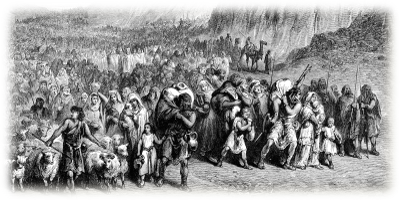Topics  Biblical Interpretation Biblical Interpretation 

How many came out of the exodus of Egypt
By Jeff A. Benner
RSV Genesis 15:13 Then the LORD said to Abram, "Know of a surety that your descendants will be sojourners in a land that is not theirs, and will be slaves there, and they will be oppressed for four hundred years;"
From this passage it would appear that the nation of Israel served at least 400 years in captivity in Egypt. The lineage of Levi as recorded in Exodus 6 and 1 Chronicles 6 indicate only 3 generations between Levi and Moses (Levi-Kohath-Amram-Moses). If the slavery began shortly after Yaacov, his children and his grandchildren entered Egypt (the "70 in all" mentioned in Exodus 1:1-5), the maximum amount of time that this lineage could have existed in slavery in Egypt is approximately 350 years. (This is assuming the Kohath was at least an infant and part of the 70 entering Egypt and Amram was born to Kohath in the year of his death and Moses was born in the year of Amram's death plus the 80 years of Moses life before the exodus).
There are two possible ways of interpreting this passage. The first is that persons are missing in the lineage from Levi to Moses, but there is no indication of this anywhere in the text. The second possibility is to interpret this passage with the four hundred years being between Abraham and the exodus, which is how Rabbinic Judaism interprets this, including the Rabbi Shaul of the New Testament.
RSV Galatians 3:16,17 Now the promises were made to Abraham and to his offspring. It does not say, "And to offsprings," referring to many; but, referring to one, "And to your offspring," which is Christ. This is what I mean: the law, which came four hundred and thirty years afterward, does not annul a covenant previously ratified by God, so as to make the promise void.
In this passage Shaul is comparing the giving of the law with the promises given to Abraham, which he identifies as 430 years. With this interpretation, Genesis 15:13 is interpreted to mean that Abraham's seed will live in a strange land which, since Ishmael was born in a strange land (Canaan), would begin with the birth of Abraham's first seed. His decedents would also serve as slaves in a land not their own (Egypt).
Abram was 86 years old at the birth of Yishmael, his first seed to be born in a strange land. Abram was 100 years old at the birth of Yitsaac. There are 14 years between the births of Yishmael and Yitsaac. Yitsaac was 60 when he bore Esav and Yaacov. Assuming that each generation began at the father's age of 60, there are 300 years from the birth of Yitsaac and the birth of Moses. Moses lived 80 years before the exodus. Adding in the 14 years between the birth of Yishmael and Yitsaac, we have 396 years between the birth of Yishmael and the exodus. This is a very close approximation to the prophecy of Genesis 15:13.
This interpretation does have three problems. The first is that Shaul says 430 years, while the actual prophecy states 400 years. This is fairly easy to resolve by simply saying that one or both of these numbers are approximates. But, Shaul does take the number 430 from a passage in the Tenakh, which brings us to the second problem.
RSV Exodus 12:40,41 The time that the people of Israel dwelt in Egypt was four hundred and thirty years. And at the end of four hundred and thirty years, on that very day, all the hosts of the LORD went out from the land of Egypt.
This text indicates that Israel dwelt in Egypt for 430 years bringing us back to the problem of the lineage. This problem may easily be solved with the following observation. The text translated as "four hundred and thirty years" is "sheloshiym (thirty) shana (year) v'arbah (and four) me'ot (hundred) shanah (year)". It is possible that the original Hebrew was written as "sheloshiym (thirty) shana (year) v'me'ot (hundred) shanah (year)". This alternate reading would be translated as "one hundred and thirty years" placing the time of bondage shortly after Yaacov's entrance into the land of Egypt.
RSV Exodus 1:8 Now there arose a new king over Egypt, who did not know Joseph.
It has been assumed that this passage takes place after the death of Yoseph (Exodus 1:6) but many times the Hebrew text demonstrates that stories are not written chronologically. It is possible that this is the reign of the Hyskos who conquered Egypt that may have happened while Yoseph was still alive and they "did not know Yoseph".
A later scribe attempting to rectify Exodus 12:41 with Genesis 15:13 inserted the word arbah (four), hence, the translation of "four hundred and thirty years". This may also explain the reason for the two different numbers given for the "slavery" of the nation of Israel in Egypt.
The third problem is the number of male descendants of Yaacov who came out of Egypt.
RSV Exodus 12:37 And the people of Israel journeyed from Rameses to Succoth, about six hundred thousand men on foot, besides women and children.
According to this passage 600,000 men descended from Yaacov left Egypt. If each man is married with an average of 5 children, this brings the entire population of Israel to 6,000,000. This is not including the mixed multitude that came out with them (Exodus 12:38) or the flocks and herds that they also brought out. This large number of people creates a few problems. The first is the size of this "army" (Exodus 12:41 - hosts meaning army. Also Exodus 12:37 where the men are called gevoriym, or warriors) compared to the size of Pharaohs army of 600 chariots (Exodus 14:7), which brought fear to the Israelites. How could 600 chariots be considered a threat to 600,000 warriors of Israel? Equally puzzling is the fear the Israelites felt at entering the Promised Land where each city probably contained no more than 5,000 warriors compared to their 600,000.
Another problem is the simple logistics to supply feed, water and move such a large number. According to the Quartermaster General in the army, it would take 1,500 tons of food, 4,000 tons of wood as fuel and 11,000,000 gallons of water each day to supply the basic needs of this group. Another problem is the location of the Latrine.
RSV Deuteronomy 23:12,13 "You shall have a place outside the camp and you shall go out to it; and you shall have a stick with your weapons; and when you sit down outside, you shall dig a hole with it, and turn back and cover up your excrement.
A camp of this size would be approximately five miles by five miles square assuming only 1,000 square feet per family. One located in the center of the camp would require a hike of 2.5 miles to use the restroom.
Another problem is the estimated population of the nation of Israel compared to the estimated population of Egypt at this time. It is estimated that the whole population of Egypt at the time of the exodus was between 2 and 5 million. According to the above estimates of the population of Israel, the people of Israel would be greater than the entire population of Egypt.
Another problem is the large number of people is not possible with the number of generations available from Levi to the exodus. The average number of children born to the descendants of Yaacov is three to five. If we assume that the twelve children of Yaacov had 5 children, and the generation of Kohath, Amram and Moses each had 5 children, the maximum number of people (men, women and children), descended from Yaacov at the time of the exodus, would be approximately 7,500.
The Hebrew text of Exodus 12:41 states; "about six hundred thousand men on foot, besides women and children," but the Hebrew text can also be translate as "about six hundred chiefs (eleph) on foot are the warriors apart from the children" (The Hebrew word eleph can mean "thousand" or "chief," compare Strong's #s 441, 504 and 505). We now have a group of warriors that would find the 600 chariots of Pharaoh a formidable army. If we also assume that each chief (head of the family) included a wife and 5 children we have about 6,000 people, which correlate with previous calculation of possible descendants from Levi to the exodus.
Translating the word eleph as "chiefs" will also work for the census records found in the book of Numbers.
RSV Numbers 1:21 the number of the tribe of Reuben was forty-six thousand five hundred.
The Hebrew of this passage could also be translated as; "The number for the tribe of Rueben is 46 chiefs and 500". With this alternate translation we have 46 chiefs and 500 family members. When we apply this method to the remainder of the tribes we come to a total number of 598 chiefs and 5,550 others.
In summary, it would appear that the slavery of the Israelites in Egypt lasted about 130 years and approximately 6,000 individuals traveled from Egypt to Mt. Sinai.
One reader posed an important question concerning this article.
The English translations typically say, "..and took six hundred chosen chariots and all the other chariots of Egypt with officers over all of them." They also mention, "The Egyptians pursued them, all Pharaoh's horses and chariots and his horsemen and his army..." Doesn't this indicate there were not just 600 chariots in Exodus 14:6-9?
First let me say that I do agree that there was more to the Pharaoh’s army than just 600 chariots. His army also would have included his horse and foot soldiers. But, I do contend that there were only 600 chariots. Let me explain.
Hebrew authors will frequently parallelisms, which are stating one thing in two or more different ways. For instance, in Psalm 119:105 we read, "Thy word is a lamp unto my feet, and a light unto my path." There is not a lamp and a light, but only one "light." The phrase "lamp unto my feet" is a parallel with "light unto my path." While this form of Hebrew poetry is commonly found in the book of Psalms, it does occur throughout the Bible. But if one were not familiar with this style of poetry, it will easily be overlooked, such as in Exodus 14:7. Here is a literal translation of this verse.
and he took six hundred chosen chariots and all the chariots of Egypt, and captains over all of them.
When we read this from an English perspective, we assume that this speaking about "six hundred chariots" and "all the other chariots" (there is no "other" in the Hebrew text). But when this is read from a Biblical Hebrew perspective, the "six hundred chariots" are "all the chariots" of Egypt.
Related Pages by Jeff A. Benner
 | | The Living Words (Book)
A study of Hebrew words in the Old and New Testament from their original Hebraic perspective. |
|






